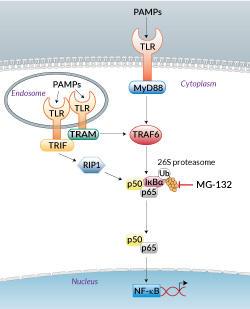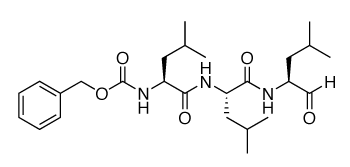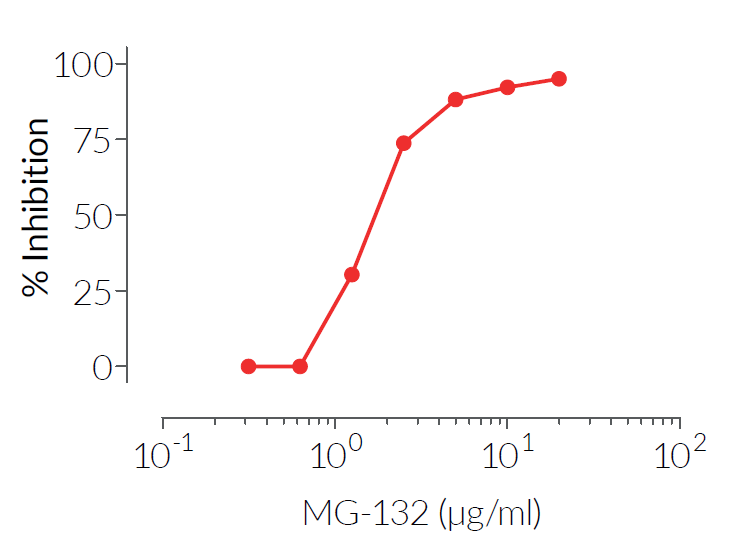MG-132
| Product | Unit size | Cat. code | Docs. | Qty. | Price | |
|---|---|---|---|---|---|---|
|
MG-132 26S proteasome inhibitor - Autophagy activator - InvitroFit™ |
Show product |
2 x 5 mg |
tlrl-mg132-2
|
|
26S proteasome inhibitor

26S proteasome inhibition by MG-132
MG-132 is a peptide aldehyde (Z-Leu-Leu-Leu-al) that selectively blocks the proteolytic activity of the 26S proteasome. The 26S proteasome is a large protease complex that degrades ubiquitinated proteins into smaller peptides. It plays a central role in the regulation of proteins that control cell-cycle progression and apoptosis.
Mode of action:
MG-132 reduces the degradation of ubiquitin-conjugated proteins in mammalian cells by the 26S proteasome. This potent inhibitor is used as a tool for disrupting the proteasome-regulated degradation of intracellular proteins, such as IκB. Inhibition of IκB proteasomal degradation by MG-132 leads to the suppression of NF-κB activation [1].
Of note, studies suggest that inhibition of the 26S proteasome by MG-132 can induce autophagy by stabilizing Atg protein levels [2].
Key features:
- A potent inhibitor of the 26S proteasome
- An autophagy inducer
- InvitroFit™ grade: each lot is functionally tested
References
1. Lee DH, Goldberg A.L., 1998. Proteasome inhibitors: valuable new tools for cell biologists. Trends Cell Biol. 8(10):397-403.
2. Ge PF. et al., 2009. Inhibition of autophagy induced by proteasome inhibition increases cell death in human SHG-44 glioma cells. Acta Pharmacol Sin. 30(7):1046-52.
Specifications
Working concentration: 200 ng/ml - 20 µg/ml (420 nM - 42 µM)
CAS number: 133407-82-6
Synonym: Z-Leu-Leu-Leu-al
Formula: C26H41N3O5
Molecular weight: 475.62 g/mol
Solubility: 20 mg/ml in DMSO
Quality control:
- The inhibitory activity has been validated using cellular assays.
- The absence of bacterial contamination (e.g. lipoproteins and endotoxins) is confirmed using HEK-Blue™ TLR2 and HEK-Blue™ TLR4 cells.
Contents
- 2 x 5 mg MG-132
![]() MG-132 is shipped at room temperature.
MG-132 is shipped at room temperature.
![]() Upon receipt, store at -20°C.
Upon receipt, store at -20°C.
Details
26S proteasome
The 26S proteasome is a large, ∼2.5 MDa, multi-catalytic ATP-dependent protease complex [1, 2]. It is responsible for the degradation of cytosolic, nuclear, and membrane proteins in eukaryotic cells, which are targeted for degradation via polyubiquitination. Proteasome-mediated degradation plays a crucial role in maintaining cell integrity by eliminating misfolded and damaged proteins. Proteasome-dependent proteolysis is also essential to regulate a number of other cellular processes, such as cell differentiation, cell-cycle progression, or apoptosis. Proteins targeted for degradation are allowed inside the proteasome particle, where they are cleaved into small peptides and released in the cytosol to be degraded into amino acids. This amino acid pool is used for the synthesis of proteins and other nitrogen-containing compounds such as DNA bases, neurotransmitters, and hormones.
References:
1. Livneh I. et al., 2016. The life cycle of the 26S proteasome: from birth, through regulation and function, and onto its death. Cell Res . 2016 Aug;26(8):869-85.
2. Adams J., 2003. The proteasome: structure, function, and role in the cell. Cancer Treat Rev .29 Suppl 1:3-9.
Chemical structure of MG-132:







